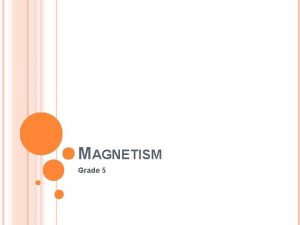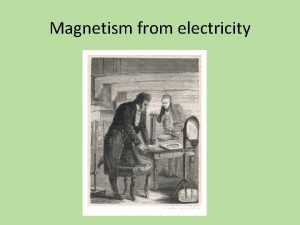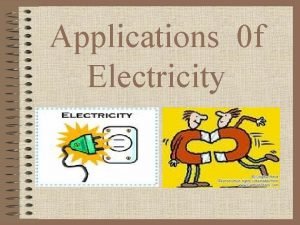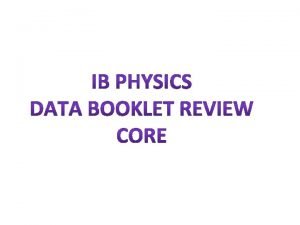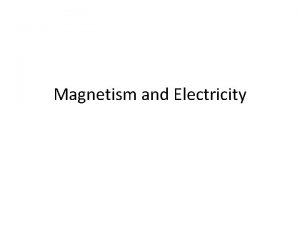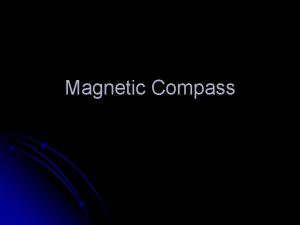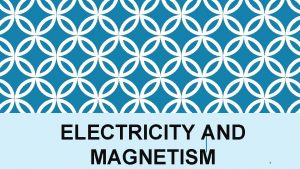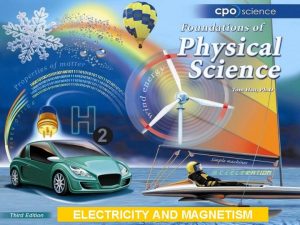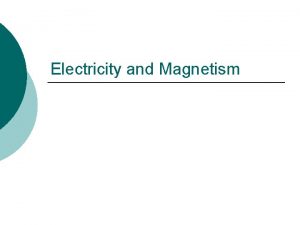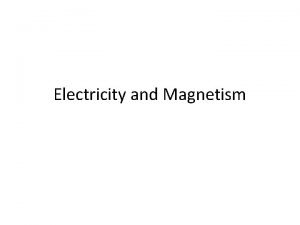Magnetism and Electricity Compasses and Lodestones Magnetic compass











- Slides: 11

Magnetism and Electricity

Compasses and Lodestones • Magnetic compass known from ancient times – Chinese probably the first (Marco Polo reported) – Compass needle prepared from lodestone – Needles float on water – Compasses have “north” and “south” ends – Like poles repel – opposites attract. – Magnetic monopoles do not exist.

Earth’s Magnetic Field • Earth acts as though there is a large bar magnet at its center – with its south magnetic pole ~4 o from Earth’s north geographic pole.

On the Move and Weakening! • The “north” end of the compass points to the south magnetic pole of the Earth • The magnetic south pole is located north of Canada and is on the move! • Strength is currently decreasing at a rate of about 6. 3% per century.

Fields in Physics 1 • A field is a hypothetical construct designed to explain action at a distance. • Two types of forces: – Contact forces • Pushing and pulling – Action-at-a-distance forces • • Gravitational force Electrical force Magnetic force Certain nuclear forces (weak and strong)

Fields in Physics 2 • Gravitational: – Arrows indicate direction of motion of any matter. – Always attractive on a “small” scale • Electrical: – Arrows indicate direction of motion of a positive test particle, e+ – Opposites attract; likes repel • Magnetic: – Arrows indicate direction of motion of a north “monopole” which DNE. – Opposites attract; likes repel

Fields in Physics 3 • The concentration of field lines indicate field strength (measured in N/kg, N/C, or Tesla) • The closer lines are, the more intense the field. • The more intense the field, the stronger the attractive or repulsive force. • When field lines point in the same direction, this indicates attraction and visa versa.

Magnetism from Electricity • Öersted shows that direct (one way) flowing electricity produces a constant magnetic field. • Ampère shows that parallel current carrying wires have an attractive force between them. • Ampère argues that currents flowing within the Earth are responsible for the planet’s magnetic field.

Faraday’s Lines of Force • Field lines trace out magnetic fields. • Magnetic fields are directed from N to S. • A long, current-carrying wire produces a circular field consistent with the right hand rule #1. • Magnetic fields of currents – the solenoid. Current is defined to flow in the same direction as a positive (+) test particle.

F on a Charge as a Result of B, v • Charged particles (+ and –) moving in a magnetic field experiences a force, F, but only so long as v is not parallel to B. • The direction of the force is given by right hand rule #2. Current is defined to flow in the same direction as a positive (+) test particle.

Electricity from Changing B Field • Faraday discovers electric induction. – Today we have the electric generator. – Charges in the presence of a changing magnetic field are forced to flow in conducting wires. – Faraday’s law – The strength of an electromotive force induced in a loop of wire is proportional to the rate at which the magnetic flux through the area of the loop changes. – AC is used in preference to DC current.
 Physics 102 electricity and magnetism
Physics 102 electricity and magnetism Ib physics topic 5 question bank
Ib physics topic 5 question bank Magnetism
Magnetism Magnetism jeopardy
Magnetism jeopardy Sph3u electricity and magnetism
Sph3u electricity and magnetism Relationship between electricity and magnetism
Relationship between electricity and magnetism Magnetism and electricity
Magnetism and electricity Electricity and magnetism grade 5
Electricity and magnetism grade 5 Electricity and magnetism
Electricity and magnetism Electric fuse and circuit breaker graphic organizer
Electric fuse and circuit breaker graphic organizer Electricity and magnetism
Electricity and magnetism Electricity and magnetism
Electricity and magnetism







